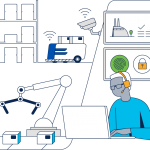Go to any conference, webinar, or talk to analysts in the manufacturing space and two of the biggest buzzwords you’ll hear are “machine learning” and “artificial intelligence” (AI). Here at Cisco, we’re exploring and investing in these areas as well and are actively driving machine learning and AI in our portfolio.
Often the two terms get misconstrued. SAS, one of our global partners, recently created an excellent video on the difference between the two:
As noted in the video:
- AI is the science of machines and computers emulating humans
- Machine learning is a method behind how machines learn from the data
So why are these topics significant, and why is there so much buzz around these areas related to the future of manufacturing? Currently, we see manufacturing in the era of Industry 4.0/Smart Manufacturing.This technical evolution has been discussed at length across this blog, but to quickly summarize from the Ultimate Guide to Manufacturing, we see three foundational areas critical for manufacturers in this journey.
- Hyperawareness: An organizational capability to recognize real-time insights and future trends. A critical component of hyperawareness is the ability to see first-hand how products and services are used in practice.
- Informed decision making: The capability to actively analyze information that arrives through hyperawareness and to ensure that it reaches those who need it most.
- Fast execution: Informed decisions must be turned into action (predictive maintenance when a plant-floor machine shows early signs of fatigue, for example).
Machine learning and AI are natural extensions of these foundational capabilities.
According to IDC:
“AI solutions will be embedded in or complementary to robotics, which manufacturers expect to help them improve product and service quality and streamline and optimize business operations. In the United States, 62% of manufacturers have already deployed robots with productivity benefits.” 1
IDC has noted that this trend in AI will continue to grow, “achieving a compound annual growth rate of 54.4% through 2020 when revenue will be more than $46 billion. 1
The foundation for machine learning and AI
The foundational piece of both machine learning and AI is data. Data will feed these platforms to help improve all facets of manufacturing and ultimately capture increasing return on investment (ROI). For example, in a simplified predictive maintenance scenario, the machine and its supervisory control system must be able to correlate its optimal performance and recognize when there are deviations from the baseline. It has to consider multiple data sources, correlate, analyze, and then come to a decision. Too much information can overpower analytics and slow things down; too little information and the machine won’t derive the value to optimize and improve intelligently. Machine learning and AI could also transform applications in areas such as supply chain optimization, research and development, and new product introductions, as just some examples.
Now consider that a factory can produce 1,000 TB of data per day, with 10,000+ sensors capturing 12,000+ variables from legacy and new machinery. Those interrelated factors are a lot to consider and mean that manufacturers not only need to consider the connectivity to the data, but that they also need to decide where that data should go, how often to send it, and how to use it. These data dynamics set the foundation as fuel for machine learning and AI.
Some data management areas to consider that support AI and machine learning:
- Frequency: Consider how often the data adds value to the business, and pull it only that often. Unnecessary data pulls can cause information overload. Adding in cloud applications for compute can also create scenarios where unsegmented data is adding unnecessary cost, overhead and affecting operational budgets.
- Prioritization: Prioritize critical data over noncritical data to ensure network integrity and help make sure that valuable information reaches the appropriate destination.
- Processing: Traditional computing models send the data to the core data center or cloud for analysis. However, this is impractical in many manufacturing scenarios. Often, machine learning and AI in manufacturing data require real-time analysis. Network architects should consider a hybrid solution of edge computing and centralized data computing to support machine learning and AI initiatives.
- Orchestration: The influx of data increases the importance of mapping out how machine learning and AI platforms receive that data and how they consume it. It’s essential to implement consistent control and awareness of the data including when it’s received, how it’s delivered, and why it was sent.
- Security: Production integrity is mission critical, but connecting multiple data feeds can introduce new security vulnerabilities. While machine learning and AI can lead to tremendous business benefits, a security breach can create data and privacy risks that can threaten a company’s reputation and customer trust. On the flip side, machine learning can also help enforce security as a means of detecting anomalies.
To help manufacturers build a foundation for machine learning and AI we developed a guide to Data Management in Digital Manufacturing. The guide provides best practices around data management and considerations for determining which workload architecture is right for you as you consider your technology roadmap. It also includes essential case studies as well as resources that can help you shift into this new data model.
- Source: IDC FutureScape: Worldwide Manufacturing 2018 Predictions, doc# DC #US42126117, October 2017,


CONNECT WITH US